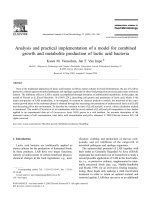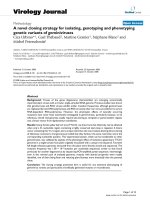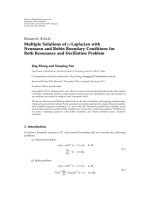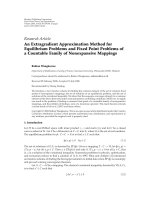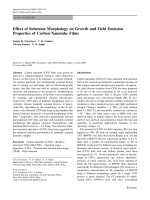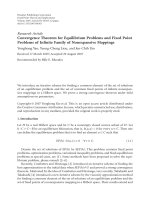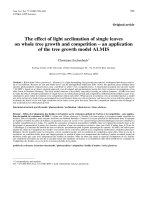Optimal culture conditions for mycelial growth and fruiting body formation of Ling Zhi mushroom Ganoderma lucidum strain GA3
Bạn đang xem bản rút gọn của tài liệu. Xem và tải ngay bản đầy đủ của tài liệu tại đây (1.46 MB, 6 trang )
Life Sciences | Biotechnology
Doi: 10.31276/VJSTE.61(1).62-67
Optimal culture conditions for mycelial growth
and fruiting body formation of Ling Zhi mushroom
Ganoderma lucidum strain GA3
Bich Thuy Thi Nguyen1, Nghien Xuan Ngo1, Ve Van Le1*, Luyen Thi Nguyen1, Ry Kana1, Huy Duc Nguyen2
Faculty of Biotechnology, Vietnam National University of Agriculture
2
Faculty of Agronomy, Vietnam National University of Agriculture
1
Received 17 November 2018; accepted 12 February 2019
Abstract:
Introduction
The objective in this study is to investigate optimal
culture conditions for mycelial growth and fruiting
body formation of the Ling Zhi mushroom, Ganoderma
lucidum strain GA3. The results of the study show that the
optimal media and temperature for the mycelial growth
are potato, glucose, and agar (PGA) supplemented with
rice bran, and 25-300C, respectively. Strain GA3 is able
to grow in a wide pH range, between 4 and 12. The most
favourable substrate mixture for the formation and
development of the fruiting body is 87% sawdust + 4%
corn powder + 8% rice bran + 1% calcium carbonate
(CaCO3).
Ganoderma lucidum (Fr.) Karst (Polyporaceae),
known as the Ling Zhi mushroom, belonging to the
family Polyporaceae (or Ganodermaceae) of the order
Aphyllophorales, has been recognised as one of the
most highly valued medicinal mushrooms in East Asian
countries for more than 2,000 years. As with other medical
mushrooms, Ling zhi is well-known for containing various
chemical substances, with approximately 119 different
triterpenes and several types of polysaccharides [1]. The
basidiocarp, mycelia, and spores of Ganoderma lucidum (G.
lucidum) are widely used in the treatment and prevention
of many diseases, such as hepatitis, hypertension,
hypercholesterolemia, and gastric cancer [2, 3].
Keywords: fruiting bodies, Ling Zhi mushroom, media,
mycelium.
Classification number: 3.5
Due to its bioactive components, irregular distribution
in the wild, and the increasing demand for it, the Ling Zhi
mushroom is artificially cultivated on various substrates for
mycelial biomass and fruiting body production [4, 5]. Grain,
sawdust, wood logs, and cork residues have been used as
basal substrates for the artificial cultivation of G. lucidum
[6-9]. A combination of beech sawdust supplemented
with 2.5% malt extract and 10% wheat bran has been
found to be the best substrate mixture for the cultivation
of G. lucidum [10]. According to Jandaik, et al. (2013)
[11], G. lucidum cultivated on paddy straw supplemented
with wheat bran exhibited the maximum yield (82.5 g)
and biological efficiency (27.5%). As previously reported
by Boh, et al. (2007) [8] and Zhou, et al. (2012) [12], the
biological efficiency of G. lucidum is strictly involved in
the environmental factors such as temperature, humidity,
oxygen, light, and carbon dioxide. In Vietnam, several
studies have focused on the classification and distribution
of the family Ganodermataceae [13]. Forty-three species
belonging to the genus Ganoderma sourced from highland
regions have been identified [14]. Of these, five species have
*Corresponding author: Email:
62
Vietnam Journal of Science,
Technology and Engineering
March 2019 • Vol.61 Number 1
Life Sciences | Biotechnology
been successfully cultivated: G. lucidum, G. applanatum,
G. australe, G. colossum, and G. subresinosum. The
search for G. lucidum strains that can possibly enhance the
mushroom’s disease resistance, yield, and medical value
plays an essential role in its cultivation. However, at the
time of writing, to our knowledge, only a few studies had
selected G. lucidum strains that could potentially produce
high yields for commercial cultivation and adapt to a broad
range of climatic conditions in Vietnam. In the course of
a previous investigation into strains from our mushroom
resource bank with such potential, strain GA3 was found to
be able to adapt better to the climatic conditions in Vietnam
than were other strains. In order to achieve a high biological
yield and reduce the time required to cultivate G. lucidum,
identifying the optimal media, and chemical, physical, and
biological factors is considered as among the most crucial
strategies. To this end, the present study sets out to determine
the optimal culture conditions for mycelial growth and
fruiting body formation for strain GA3.
Materials and methods
Table 1. Composition of various culture media for mycelial
growth.
Media
Composition of
media (g/l)
Raper
PGA
PGA supplemented
with rice bran
extract
PGA supplemented
with fresh oyster
mushroom extract
Glucose
20
20
20
20
Yeast extract
2
-
-
-
Peptone
2
-
-
-
Potatoes
-
250
250
250
KH2PO4
0.46
-
-
-
K2HPO4
1
-
-
-
MgSO4.7H2O
0.5
-
-
-
Rice bran
-
-
20
-
Fresh oyster
mushroom
-
-
-
25
Agar
20
20
20
20
pH
7
7
7
7
Effect of temperature on mycelial growth
Mushroom strain
The G. lucidum strain GA3 used in this study was
collected in Japan. Pure mycelial cultures were isolated
from internal tissue following the protocol described by
Jonathan and Fasidi (2003) [15]. The culture was maintained
on a PGA medium in complete darkness and stored in a
refrigerator at 5-70C for further study.
Effect of different media on mycelial growth
Four different kinds of culture media - Raper, PGA, PGA
supplemented with rice bran extract, and PGA supplemented
with fresh oyster mushroom extract- were used to ascertain
the optimal media for promoting the vegetative growth of
strain GA3. To prepare the PGA, PGA supplemented with
rice bran extract, and PGA supplemented with fresh oyster
mushroom extract media, after peeling, potatoes were
cut into small pieces, and then boiled in 500 ml distilled
water for 30 minutes. Twenty grams of rice bran (PGA
supplemented with rice bran extract) and 25 g of fresh
oyster mushroom (PGA supplemented with fresh oyster
mushroom extract) were extracted using 250 ml of warm
and hot water, respectively. The crude extract obtained was
filtered by means of a steel mesh. Thereafter, these two
liquids were mixed thoroughly. Twenty grams of glucose
and 20 g of agar were dissolved and added to the medium.
The final volume of the media was increased to one litre by
adding water. The media were sterilised by autoclaving at it
1210C for 60 minutes. The composition of the culture media
is shown in Table 1.
Following the media experiment, strain GA3 was
inoculated on PGA supplemented with rice bran at pH 7
and incubated in darkness at four different temperatures
(20±10C; 25±10C, 30±10C and 35±10C).
Effect of different initial pH levels on mycelial growth
The growth of G. lucidum strain GA3 on PGA
supplemented with rice bran at 30±10C and different pH
levels was tested between pH 3.0 and 12.0 in increments of
1.0 pH units. pH levels were initially adjusted by using 1M
sodium hydroxide (NaOH) or hydrochloric acid (HCl).
Effect of substrate mixtures on fruiting body formation
To investigate the most favourable substrate mixtures
for fruiting body formation, G. lucidum was cultivated
on rubber (Hevea brasiliensis) wood sawdust as the basal
substrate with different types of supplements added, as
indicated in Table 2.
Table 2. Composition of substrate mixtures for fruiting body
formation.
Composition (%)
Treatment
1
2
3
4
5
Sawdust
87
87
87
87
87
Corn powder
4
4
4
4
4
Rice bran
8
6
4
2
0
Wheat bran
-
2
4
6
8
CaCO3
1
1
1
1
1
March 2019 • Vol.61 Number 1
Vietnam Journal of Science,
Technology and Engineering
63
Life Sciences | Biotechnology
Data collection
Important characteristics of mycelial morphology such
as texture (cottony, floccose), density (high, moderate, low),
and colour (off-white, white) were recorded by means of
visual observation. Diameter growth (mm) was measured at
5, 7, and 9 days after inoculation. The mycelial growth rate
was calculated as follows: V = D/T, where V is the mycelial
growth rate (mm/day), D is as the diameter growth (mm),
and T is the duration of mycelial growth (days).
The period of surface colonisation (days) was defined as
the time required for the mycelium to grow throughout the
media and establish total colonisation on the bag surface.
The period of primordia formation (days) was defined as
the time required for the formation of primordia from the
time of inoculation. The length of stalk (cm) and width of
fruiting body (cm) were measured. Biological efficiency was
measured as the ratio of the mass of dry fruiting body (g)
per dry mass of substrate (g) and expressed as a percentage.
Statistical analysis
The data obtained were statistically analysed using
GraphPad Prism (version 7.0, GraphPad Software Inc., San
Diego, CA). Each treatment was replicated three times.
Differences among the means of groups were assessed
using two-way ANOVA followed by Tukey multiple range
test, with p<0.05. Values in the same column in a table with
different letters were considered to differ significantly.
Results and discussion
Effect of media on mycelial growth of strain GA3
Nutrients, temperature, light, and pH are known to
be significant factors that noticeably influence onthe
mycelial growth of mushrooms. To investigate the optimal
media for rapid mycelial growth of strain GA3, diameter
growth, and mycelial morphology (texture, density, and
pigmentation) were recorded in the four different culture
media. As shown in Fig. 1 and Table 3, strain GA3 was
able to grow in all four kinds of media. Flocculence and
whiteness were identified as the main mycelial morphology
and pigmentation, respectively. Maximal mycelial growth
was observed on PGA supplemented with rice bran extract,
with an average mycelial growth rate of 9.29±0.11 mm/day.
PGA was determined to be unsuitable media for mycelial
growth of GA3. PGA supplemented with rice bran
exhibited high mycelial density. In contrast, the mycelial
density of GA3 was found to be moderate on Raper and
PGA supplemented with oyster mushroom fresh but low on
PGA media. These results suggest that PGA supplemented
with rice bran may be considered the optimal media for
64
Vietnam Journal of Science,
Technology and Engineering
mycelial growth of strain GA3 and this was therefore
selected for further optimisation. Jayasinghe, et al. (2008)
[16] report that Hamada (dextrose, ebiose, hyponex yeastextract), Glucose Peptone (glucose, malt-extract, peptone,
yeast-extract), Yeast-Malt extract (dextrose, malt-extract,
peptone, yeast-extract), Mushroom Complete (malt-extract,
peptone, yeast-extract, K2HPO4, MgSO4, KH2PO4) and Lilly
(asparagine, maltose, MgSO4, KH2PO4) are suitable media
for the growth of G. lucidum. As reported by Badalyan, et
al. (2015) [17], the mycelial morphology of G. lucidum is
white and felt/cottony, with denser aerial mycelium in the
centre during the initial incubation period stage of growth.
Fig. 1. Mycelial growth on different media, incubated in
darkness for 9 days at 250C, pH 7. (A) Raper; (B) PGA; (C) PGA
supplemented with rice bran; (D) PGA supplemented with oyster
mushroom fresh.
Table 3. The influence of different culture media on the mycelial
growth performance of strain GA3 at 250C, pH 7.
Media
Diameter growth (mm) after days
5
7
Mycelial characteristics
9
Density
Texture
Pigmentation
Raper
20.39±0.43
35.33±0.63
46.16±1.42
Moderate
Floccose
White
PGA
14.50±0.48b
23.16±0.17b
29.94±1.13b
Low
Floccose
White
PGA + rice bran
24.28±0.62c
60.5±0.82c
83.68±1.06c
High
Floccose
White
PGA + oyster
mushroom fresh
21.28±0.22d
57.50±0.35d
71.39±0.11d
Moderate
Floccose
White
a
a
a
Effect of temperature level on mycelial growth of strain
GA3
As with the media, temperature is one of the most
significant physical factors affecting both the growth
of mycelium and fruiting body formation. According to
Jayasinghe, et al. (2008) [16], favourable mycelial growth
of G. lucidum was recorded at 25-300C. However, it is
worth noting that a range of temperatures, between 30
and 350C, was found suitable for mycelial growth of G.
lucidum [18, 19]. To ascertain the optimal temperature for
favourable mycelial growth of strain GA3, the mycelial
growth pattern was recorded at four different temperatures,
20±10C, 25±10C, 30±10C, and 35±10C for 5, 7, and 9 days.
The results indicate that the incubation temperature has a
significant influence on the growth of strain GA3. Optimal
mycelial growth was observed at 300C, followed by 250C
and 200C, as indicated in Fig. 2 and Table 4.
March 2019 • Vol.61 Number 1
Life Sciences | Biotechnology
Fig. 2. Mycelium growth of strain GA3 grown in darkness on
PGA medium supplemented with rice bran for 7 days at pH
7 after inoculation at various temperatures. (A) 20±10C; (B)
25±10C; (C) 30±10C; (D) 35±10C.
Table 4. The influence of different temperatures on mycelial
growth performance. Strain GA3 was grown on PGA medium
supplemented with rice bran at pH 7.
Temperature Diameter growth (mm) after days
Mycelial density
(oC)
5
Density
20±1
27.89±0.15a 43.22±0.20a 76.22±0.37a Moderate Floccose White
25±1
39.83±0.33b 66.61±0.20b 85.89±0.31b High
30±1
48.94±0.20c 74.94±0.48c 90.00±0.15c Moderate Floccose White
35±1
21.05±0.28d 39.50±0.29d 54.39±0.42d Moderate Floccose White
7
9
Texture Pigmentation
Floccose White
Effect of different initial pH levels on mycelial growth Fig. 3. Mycelium growth of strain GA3 grown in darkness on PGA medium
Fig. 3. Mycelium
strain
GA3
grown
in inoculation
darkness at
on30 oC.
supplemented
with rice growth
bran for 3ofdays
(A) and
7 days
(B) after
of strain GA3
One of the most important chemical factors, pH can affect
cell membrane function, the uptake of various nutrients, cell
morphology and structure, the solubility of salts, the ionic
state of substrates, enzyme activity, and product biosynthesis
[20]. Rai (2003) [18] has reported that G. lucidum prefers
an acidic pH for vegetative growth. In addition, a pH range
from 4.0 to 6.5 was found to be the optimal initial pH for
the growth of G. lucidum, as previously described by Veena
and Pandey (2006) [19]. According to Kapoor and Sharma
(2014) [21], G. lucidum can grow in a broad range of pH
values, from 3.0 to 11.0, though the highest mycelial growth
rate was observed at the pH 5.0 level. As indicated by
Jayasinghe, et al. (2008) [16], the optimal pH for mycelial
growth varies widely and is strongly related to the genotype
of strain. Remarkably, strain GA3 is capable growing in a
wide pH range, from 4 to 12, as shown in Fig. 3 and Fig. 4.
PGA medium supplemented with rice bran for 3 days (A) and 7
days (B) after inoculation at 300C.
4. Effect of initial pH on mycelial growth of strain GA3.
Effect of substrate mixtures on fruiting body formationFig. 4.Fig.
Effect of initial pH on mycelial growth of strain GA3.
of strain GA3
lucidum [23]. Compared to poplar and beech sawdust,
Effect
of substrate
on fruiting
body formation
of strain GA3of G.
As previously reported, the yield and biological oak
sawdust
wasmixtures
observed
to support
the cultivation
efficiency of G. lucidum relate not only to the kind of lucidum
As previously
the yield
and biological
efficiency
of G. lucidum
relate not only
andreported,
produced
the highest
biological
efficiency
[22].
to
the
kind
of
sawdust
but
also
the
supplements
used
[22].
Sawdust
is
used
sawdust but also the supplements used [22]. Sawdust is The effect of various kinds of substrate mixtures on fruitingas the basal
in mixtures for cultivating G. lucidum [23]. Compared to poplar and beech
used as the basal substrate in mixtures for cultivating G. substrate
body formation
of G. lucidum was investigated in this study.
sawdust, oak sawdust was observed to support
the cultivation of G. lucidum and produced
the highest biological efficiency [22]. The effect of various kinds of substrate mixtures on
fruiting body formationof G. lucidum was investigatedin this study.
Vietnam Journal of Science,
this experiment,
five treatments
were used toin order to ascertainthe
March In
2019
• Vol.61 Number
1
65most effective
and Engineering
treatment for the growth of mycelialTechnology
andfor fruiting
body formation. To cultivate strain
GA3, corn powder, rice bran, and wheat bran wereused as major nutrients to supplement
the substrate.The period required for surface colonisation, primordia formation, the length
Life Sciences | Biotechnology
Bag colonization
(days)
Primordia formatioon
(days)
5A, 5B, 5C, 5D, 5E, 5F, and 5G, respectively. The results
presented in Figs. 5A, 5B indicate that strain GA3 is able
to grow to form primordia in all five treatments. The pilei
of strain GA3 were found to be kidney-shaped (Fig. 6).
Compared with other treatments, treatment 2 (87% sawdust
+ 4% corn powder + 6% rice bran + 2% wheat bran + 1%
CaCO3) and treatment 1 (87% sawdust + 4% corn powder
+ 8% rice bran + 1% CaCO3) reduced the time required
for surface colonisation, bag colonization, and primordia
formation and resulted in a significantly higher growth rate
(Figs. 5A, 5B, and 5D). As expected, the greatest fresh mass
(17.16 g) and biological efficiency (2.56%) were obtained
with treatment 1, followed by treatment 2 (16.66 g and
2.49%) (Fig. 5E). Rice bran and corn powder are known to
have high vitamin content, especially vitamin B2. This is
may be due to the presence of high percentage of rice bran
in the substrate mixtures of treatments 1 and 2. In contrast,
treatments 4 and 5 showed a lower biological efficiency
(13.13 g and 1.96%, and 13.20 g and 1.97%), respectively.
Therefore, treatment 1 (87% sawdust + 4% corn powder +
8% rice bran + 1% CaCO3) is considered the most suitable
substrate combination for cultivating strain GA3.
(B)
Mycelial growth rate
(cm/days)
Length of fruiting body
(cm)
(A)
(D)
Biological effeciency
(%)
Width of fruiting body
(cm)
(C)
(F)
Length of stalk
(cm)
(E)
Conclusions
(G)
The optimal conditions for mycelial growth of strain
GA3 were observed at 25-300C on PGA media supplemented
rice bran. Strain GA3 grew in a wide pH range, from 4 to
12. Of the five treatments used for cultivating of G. lucidum,
treatment 1 (87% sawdust + 4% corn powder + 8% rice bran
+ 1% CaCO3) was the most suitable substrate mixture for
improving biological efficiency.
10
ACKNOWLEDGEMENTS
(A)
(B)
(C)
(D)
(E)
Fig. 6. Fruiting body of Ganoderma lucidum strain GA3 cultivated
using different treatments. (A) treatment 1; (B) treatment 2; (C)
treatment 3; (D) treatment 4; (E) treatment 5.
In this experiment, five treatments were used to in order
to ascertain the most effective treatment for the growth of
mycelial and for fruiting body formation. To cultivate strain
GA3, corn powder, rice bran, and wheat bran were used
as major nutrients to supplement the substrate. The period
required for surface colonisation, primordia formation,
the length of the fruiting body, the mycelial growth rate,
biological efficiency, the width of fruiting body, and the
length of the stalk were monitored and are shown in Figs.
66
Vietnam Journal of Science,
Technology and Engineering
This study was partially funded by Vietnam National
University of Agriculture as a “research working group
project”.
The authors declare that there are no conflicts of interest
regarding the publication of this article.
REFERENCES
[1] S. Wachtel-Galor, J. Yuen, J.A. Buswell, I.F.F. Benzie (2011),
“Ganoderma lucidum (Lingzhi or Reishi): a medicinal mushroom”,
Herbal Medicine: Biomolecular and Clinical Aspects (2nd edition),
CRC Press/Taylor & Franci.
[2] E.I. Erkel (2009), “The effect of different substrate mediums
on yield of Ganoderma lucidum (Fr.) Karst”, J. Food Agric. Environ.,
77(3), pp.841-844.
[3] T. Mizuno, W-Y. Wang, J. Zhang, H. Kawagishi, T. Nishitoba,
and J.X. Li (1995), “Reishi, Ganoderma lacidium and Ganoderma
tsugae: bioactive substance and medicinal effects”, Food and Reviews
March 2019 • Vol.61 Number 1
Life Sciences | Biotechnology
International, 11(1), pp.151-166.
[4] N. Ninluam, W. Potiprasert, U. Romreun, E. Bangyeekhun
(2016), “Cultivation of Lingzhi mushroom, Ganoderma lucidum,
by using sugarcane bagasse”, Veridian E-Journal, Science and
Technology Silpakorn University, 3(6), pp.390-397.
[5] S.T. Chang, J.A Buswell (2008), “Safety, quality control and
regulational aspects relating to mushroom nutriceuticals”, Proc. 6th
Intl. Conf. Mushroom Biology and Mushroom Products, pp.188-195.
[6] S.T. Chang, J.A. Buswell (1999), “Ganoderma lucidum (Curt.:
Fr.) P. Karst. (Aphyllophoromycetideae): a mushrooming medicinal
mushroom”, Int. J. Med. Mushrooms, 1(2), pp.139-146.
[7] S.P. Wasser, P. Coates, M. Blackman, G. Cragg, M. Levine, J.
White (2005), Encyclopedia of Dietary Supplements, Marcel Dekker,
pp.680-690.
[8] B. Boh, M. Berovic, J. Zhang, L. Zhi-Bin (2007), “Ganoderma
lucidum and its pharmaceutically active compounds”, Biotechnol.
Annu. Rev., 13, pp.265-301.
[9] H. Riu, G. Roig, J. Sancho (1997), “Production of carpophores
of Lentinus edodes and Ganoderma lucidum grown on cork
residues”, Microbiologia SEM, 13, pp.185-192.
[10] M. Azizi, M. Tavana, M. Farsi and F. Oroojalian (2012),
“Yield performance of Lingzhi or Reishi medicinal mushroom,
Ganoderma lucidum (W. Curt.: Fr.) P. Karst. (Higher Basidiomycetes),
using different waste materials as substrates”, Int. J. Med. Mushrooms,
14(5), pp.521-527.
[11] S. Jandaik, R. Singh, M. Sharma (2013), “Comparative
growth characteristics and yield attributesof Lingzhi or Reishi
medicinal mushroom, Ganoderma lucidum (Higher Basidiomycetes)
on different substrates in India”, Int. J. Med. Mushrooms, 15(5),
pp.497-503.
[12] X.W. Zhou, K.Q. Su and Y.M. Zhang (2012), “Applied
modern biotechnology for cultivation of Ganoderma and development
of their products”, Appl. Microbiol. Biotechnol., 93(3), pp.941-963.
[13] D.T. Ha, L.T. Loan, T.M. Hung, L.V.N. Han, N.M. Khoi, L.V.
Dung, B.S. Min and N.D. Nguyen (2015), “An improved HPLC-DAD
method for quantitative comparisons of triterpenes in Ganoderma
lucidum and its five related species originating from Vietnam”,
Molecules, 20(1), pp.1059-1077.
[14] P.D.N. Nguyen, H.T. Do, B.D. Le (2013), “Characteristics of
ecological factors and their distribution of Ganodermataceae Donk. in
highlands of Vietnam”, J. Biol., 35, pp.198-205.
[15] S.G. Jonathan, I.O. Fasidi (2003), “Studies on Psathyrella
atroumbonatai (Pegler), a Nigerian edible fungus”, Food Chem.,
81(4), pp.481-484.
[16] C. Jayasinghe, A. Imtiaj, H. Hur, G.W. Lee, T.S. Lee, U.Y.
Lee (2008), “Favorable culture conditions for mycelial growth of
Korean wild strains in Ganoderma lucidum”, Korean J. Mycol., 36(1),
pp.28-33.
[17] S.M. Badalyan, A.V. Shnyreva, M. Lotti, and A. Zambonelli
(2015), “Genetic resources and mycelial characteristics of several
medicinal polypore mushrooms (Polyporales, Basidiomycetes)”, Int.
J. Med. Mushrooms, 17(4), pp.371-384.
[18] R.D. Rai (2003), “Successful cultivation of the medicinal
mushroom Reishi (Ganoderma lucidum) in India”, Mushroom Res.,
12, pp.87-91.
[19] S.S Veena and M. Pandey (2006), “Evaluation of the locally
available substrates for the cultivation of indigenous Ganoderma
isolates”, J. Mycol. Pl. Pathol., 36(3), pp.434-438.
[20] V. Elisashvili (2012), “Submerged cultivation of medicinal
mushrooms: bioprocesses and products (Review)”, Int. J. Med.
Mushrooms, 14(3), pp.211-239.
[21] P. Kapoor and B.M. Sharma (2014), “Studies on different
growth parameters of Ganoderma lucidum”, International Journal of
Science, Environment and Technology, 3(4), pp.1515-1524.
[22] O.K. Gurung, U. Budathoki, and G. Parajuli (2012), “Effect
of different substrates on the production of Ganoderma lucidum
(Curt.: Fr.) Karst”, Our Nature, 10(1), pp.191-198.
[23] E. Erkel (2009), “Yield performance of Ganoderma lucidum
(Fr.) Karst cultivation on hosts containing different protein and
carbohydrate source”, Afr. J. Agric. Res., 4(11), pp.1331-1333.
March 2019 • Vol.61 Number 1
Vietnam Journal of Science,
Technology and Engineering
67
